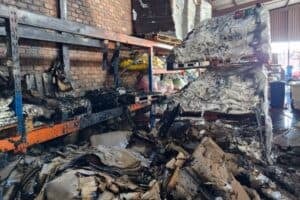The sprinklers were supposed to be serviced in February 2020, according to the City of Cape Town's Fire Department Station Commander.

Parliament’s sprinkler system has not been serviced since 2017 despite it needing to be maintained every three years, the City of Cape Town’s report has revealed.
The report, which the city insisted is not an official fire report on the incident, was made public on Friday.
“This is a post-incident report prepared by the City’s Fire Department on the fire that engulfed Parliament.
“It reflects the observations of professionals, but does not in any way constitute or substitute for a full forensic investigation conducted by professional fire investigators,” Cape Town mayor Geordin Hill-Lewis said in a statement.
Hill-Lewis also confirmed that the report has since been sent to National Assembly Speaker Nosiviwe Mapisa-Nqakula.
READ MORE: Parliament confirms roof fire flare-up contained
A team of engineers on Monday were deployed by the Department of Public Works and Infrastructure to inspect and assess the damage to Parliament.
A preliminary report was expected to be released on Friday, according to Public Works and Infrastructure Minister Patricia de Lille.
“I can’t say with confidence that they will be able to give me a preliminary report by Friday,” De Lille told Parliament on Tuesday.
Sprinkler system
The City’s report, meanwhile, has revealed that the National Assembly’s sprinkler valve was not serviced since 2017.
According to the City’s Fire Department Station Commander, JJ Williams, the sprinklers were supposed to be serviced in February 2020.
“During my walk around of the affected areas, I found that the National Assembly sprinkler valve was not serviced. [The] service date was in 2017 and this needs to be done every three years.
“If properly serviced, this valve should have been locked with a chain in an open position and a block plan would have been available showing [the] system layout,” he said.
This meant, Williams said, that there was no water to trigger the automatic sprinkler system when the fire broke out on Sunday.
“The sprinkler system did not activate, was not serviced, valves appeared to have been closed. These should have been locked open with a chain,” he said.
ALSO READ: Parliament fire: Expert explains why repairs could take ‘many months’
Williams said it is unclear what portions of the building are fitted with sprinklers.
He also said the required block plan is not legible.
The report contradicts what was said by Public Works and Infrastructure, project manager Thembeka Kolele earlier in the week.
Kolele told the Joint Standing Committee on the Financial Management of Parliament that the sprinkler system was “fully functional” by October last year.
Kolele also said the sprinkler systems were checked after a power failure on 21 December that affected the whole of Cape Town.
“The department can confirm that all the equipment and all the buildings in the precinct are regularly maintained. For the fire sprinkler system, it is serviced annually and we do the repairs when there’s an issue picked up in the system,” Kolele said.
De Lille also confirmed during an interview with Radio 702 that the fire sprinklers were tested last month.
This video is no longer available.
Latches
The report, meanwhile, also indicated that the National Assembly’s fire doors did not work because they were latched open.
“Fire doors were locked in an open position using latches. The latching open of fire doors assisted in the spread of the fire,” Williams added.
On Thursday, Cape Town MMC for Safety and Security, JP Smith dismissed reports that Parliament’s fire doors were rendered useless because the latches were cheap.
READ MORE: Parliament fire suspect’s attorney accuses the government of making him scapegoat
“The report found that the fire doors were disabled by being latched open. So it is not the price or the quality of the latch, the point is the fire door that is meant to compartmentalise a building so that fire doesn’t spread beyond a certain point were opened.
“The fire doors are in passages and corridors where presumably people need to pass through, and so instead of having the difficulty in opening or closing those, some of them were simply latched,” he told Radio 702.
Alarm system
On the fire alarm system in the National Assembly, Williams said it was unclear if the alarm and detection system was operational.
“No fire alarm was received by Cape Town Fire Service from the old or new National Assembly buildings. An alarm was received after the firefighters were already on scene from Tuynhuys adjacent to the assembly buildings,” he said.
“The fire detection system appears faulty, but was badly damaged in the fire. Its operational status still needs to be determined in the investigation.”
The report stated that the smoke vents in the roof of the National Assembly did activate, while fire extinguishers and hose reels appeared to have been serviced.
Hawks takeover
The Parliament building has since been handed over to the Hawks, who will investigate the circumstances around the devastating fire.
The fire affected both the Old Assembly Wing and the National Assembly Wing of the buildings of Parliament, which house the chambers of the National Assembly and the National Council of Provinces (NCOP).
The Hawks investigators are expected to gain access to the buildings once they receive confirmation from the multidisciplinary team of engineers, including structural, electrical, and forensic experts.
Additional reporting by Narissa Subramoney






